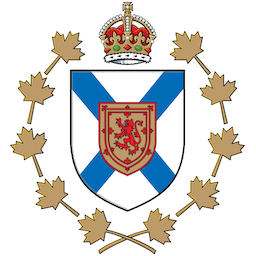Symbols of Office
Great Seal
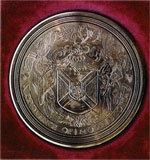
Authorized in 1730, the Great Seal of Nova Scotia was the first of its kind in Canada.
The Seal is engraved on either side with the royal arms and the provincial arms. The purpose of the Seal is to manifest the authority of the Crown at the provincial level and permits documents to be ‘signed and sealed’ at Halifax.
Using seals to indicate ‘sovereign will’ is a tradition passed down from the British colonial system of government. The keeper of the Great Seal is the Minister of Justice who receives it from the Lieutenant Governor upon being sworn into office. The Seal is returned by the Minister when the Lieutenant Governor leaves office.
Respect for, and protection of, the Great Seal and its associated powers is enshrined in a provincial statute known as Lieutenant Governor and Great Seal Act.
The Lieutenant Governor's Flag

The Lieutenant Governor has a personal flag called the Vice-Regal Flag; formally known as the Flag of the Office of the Lieutenant Governor. This flag is flown on vehicles and at Government House when the Lieutenant Governor is in residence and also on any building or Canadian vessel where the Lieutenant Governor is present.
The flag consists of a blue background displaying the Emblem of the Office of the Lieutenant Governor in the centre. The Vice-Regal Flag is the same pattern as that used by other Lieutenant Governors.
The Nova Scotia Vice-Regal Flag was updated through Letters Patent on the advice of the Executive Council for the Province. It was inaugurated on Victoria Day, the official birthday of His Majesty King Charles III, 20 May 2024 following a brief ceremony in front of Government House.
The Seal of the Lieutenant Governor
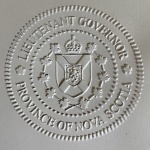
The Privy Seal of the Lieutenant Governor (commonly referred to as the Seal of the Lieutenant Governor) is used on many official documents, from Commissions appointing Honorary Aides de Camp, to appointment documents making an individual a Notary Public, and other documents requiring an embossed seal. The Seal of the Lieutenant Governor is impressed on a red wafer (label) that is affixed to the document being sealed.
The current format of Privy Seal was adopted in 2009 and displays the Vice-Regal emblem in the centre. It was revised in October 2023 to replace the St. Edward’s Crown with the Tudor Crown, and also to add two small mayflowers (the Provincial flower) in the legend. A similar seal also exists for the Administrator of the Government of the Province. Prior to the 2009 format of Privy Seal, the Seal consisted of the Lieutenant Governor’s initials and name or occasionally a heraldic crest.
The Royal Key
The Royal Key was presented to Queen Elizabeth II at Government House on the 28th of June 2010. The Honourable Mayann E. Francis, the 31st Lieutenant Governor of Nova Scotia, presented the Royal Key to The Queen to signify that Government House is the Sovereign's home in Nova Scotia. At future installation ceremonies held for Lieutenant Governors the Royal Key will be presented by the retiring Lieutenant Governor to their successor to symbolize the transfer of responsibility over Government House to the new Lieutenant Governor. Royal visitors to Government House will also be presented with the Royal Key upon signing the Government House guest book. The key is presently on display in a display case located in the Ballroom of Government House.
The key itself is made of gilded sterling silver and was made in the United Kingdom in 1908. It was custom engraved with the Royal Cypher of Her Majesty The Queen and the following text "The Royal Key was presented to Her Majesty Queen Elizabeth II, Queen of Canada, 28 June 2010." The key also bears the text "1800 Government House 2010" noting the date the cornerstone of the building was laid and the completion date of the renovation of Canada's oldest official residence. The flange of the key bears the latin text "Deo Favente" which means "God Favour" the same words scrawled on a piece of paper found under the cornerstone of Government House.
Emblem of the Office of the Lieutenant Governor
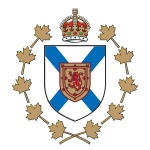
Granted by the Chief Herald of Canada on 20 July 2007, the Vice-Regal Emblem is the primary symbol of authority of the Office of the Lieutenant Governor of Nova Scotia. The centre of the Emblem bears the shield of arms taken from the Nova Scotia Provincial Arms, which were granted in 1625 by King Charles I. The ten maple leaves symbolize each of Canada's provinces, while the Crown symbolizes the Sovereignty of Canada and our Head of State, His Majesty The King, whom the Lieutenant Governor represents in the province. Similar emblems are used throughout Canada by other vice-regal offices. Prior to 2007, the Office of the Lieutenant Governor used a plain Royal Crown as its primary symbol of authority, this continues to be used by a number of Governors General throughout the Commonwealth.
The Royal Crown was updated to the Tudor style Royal Crown in advance of King Charles III's Coronation, following His Majesty's adoption of his Royal Cypher in September 2022. As supplies of printed and physical products carrying the Vice-Regal Emblem are exhausted, the updated version will be implemembed.
The emblem is used on the Flag of the Office of the Lieutenant Governor, letterhead, envelopes, business cards, the license plates on the Lieutenant Governor's car, lapel pins and other items. It is the principal visual identity symbol of the Office of the Lieutenant Governor and Government House, Halifax.
Vice-Regal Recognition Badge
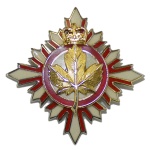
Upon assumption of office, the Lieutenant Governor is presented with two Vice-Regal Recognition Badges. The full-sized badge is a star shaped badge measuring six centimetres across, made of sterling silver, enameled in Canada's national colours, red and white, and defaced in the centre with a gold maple leaf surmounted by a Royal Crown. The badge is worn on the left side of a suit, dress or blouse. The lapel-sized badge measures three centimeters in height and is circular in shape, with red and white enamel, and a single gold maple leaf in the centre surmounted by a Royal Crown. The lapel badge is suitable for less formal functions, and can be worn on the lapel, similar to the way that the Order of Canada and Order of Nova Scotia lapel pins are worn by recipients of those orders.
The Vice-Regal Recognition Badge was established by a vice-regal warrant on 27 January 1999 and the first badges were presented on 3 October 1999 by then Governor General Romeo LeBlanc. The first Lieutenant Governor of Nova Scotia to receive the Vice-Regal Recognition Badge was The Honourable James Kinley in 1999. If a Lieutenant Governor has a spouse the spouse is entitled to wear a similar badge, the main difference being that the maple leaf in the centre of the full size badge and lapel badge is silver in colour.
Government House Bookplate
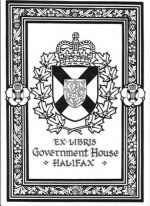
It has long been custom to denote ownership of books by affixing a bookplate on the inside cover. A number of Lieutenant Governors commissioned personal bookplates that incorporated their personal coats of arms.
The Government House bookplate was designed and drawn by renowned heraldic artist Gordon MacPherson, CM, FRHSC. It incorporates both the Emblem of the Office of the Lieutenant Governor in the centre and the badge of the Order of Nova Scotia along each side. This bookplate can be found in the front of all books owned by Government House.
Lieutenant Governor’s Challenge Coin
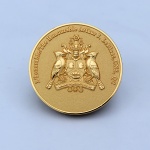
Following a tradition that is now common amongst Flag and General Officers in the Canadian Armed Forces, a Lieutenant Governor’s Challenge Coin was commissioned. They are given out by the Lieutenant Governor as small gifts to visitors and those who have aided the Office of the Lieutenant Governor in a special way.
The obverse of the medal depicts the personal coat of arms of the Lieuentant Governor and is circumscribed by the Lieutenant Governor's name and postnominals. The reverse depicts the vice-regal emblem and is circumscribed by the text “Lieutenant Governor of Nova Scotia” “Lieutenant-gouverneur de la Nouvelle-Ecosse”.
Civil Uniform
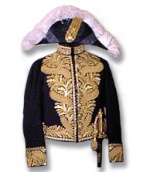
The Lieutenant Governor wears the Civil Uniform for Speeches from the Throne, the New Year's Levee and other special events. The Civil Uniform is almost exclusively worn by a number of Lieutenant Governors in Canada and over the past 60 years it has become inexorably linked with those who represent the Crown in the provinces.
The Civil Uniform presently worn by the Lieutenant Governor of Nova Scotia is a 2nd Class Half Dress Civil Uniform. It originally belonged to The Honourable Sir Frederick William Borden, MP for Windsor Nova Scotia and long serving Minister of Militia and Defence (1896-1911). This same uniform has been worn by most of Nova Scotia's Lieutenant Governors since the Borden family gave the uniform to the Office of the Lieutenant Governor following Sir Frederick's death in 1917.
Banner of the Order of Nova Scotia

Approved by the Lieutenant Governor in 2023, the Banner of the Order of Nova Scotia is flown at Government House on occasions when the Lieutenant Governor is presiding over an investiture of the Order, when the Advisory Council of the Order is meeting and on 2 August, commemorating the day the Order of Nova Scotia Act was proclaimed by the Lieutenant Governor. The Banner was first flown on 9 November 2023 at the annual Order of Nova Scotia investiture.
More Information
For more information on these and other vice-regal symbols, see:
- The Symbols of Canada (Ottawa: Department of Canadian Heritage, 2008)
- Sir Conrad Swan, Canadian Symbols of Sovereignty (Toronto: University of Toronto Press, 1976)
- Christopher McCreery, The Canadian Honours System (Toronto: Dundurn Press, 2005)
